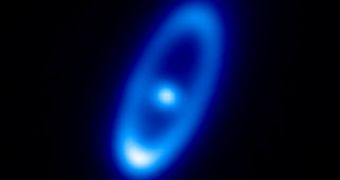Officials with the European Space Agency (ESA) say that the Herschel Space Observatory – the world's most advanced telescope – has recently observed the area around the star Fomalhaut. The team behind the study found that thousands of icy comets are destroyed there every single day.
Previous observations identified a dusty belt around the nearby star, but investigators could not tell for sure what the disk was made up of. Recently, they used observations from Herschel to conclude that the feature is actually composed of icy material from comets.
It's important to keep in mind that Fomalhaut is a very young star, just a few hundred million years old. By comparison, the Sun is around 4.6 billion years old. Astronomers first discovered the nearby object around 30 years ago, via the IRAS satellite.
However, researchers had access to limited technical means at the time, and could not photograph the structure of the disk in detail. Using the ESA telescope, experts were able to produce images depicting the structure in the far-infrared portion of the electromagnetic spectrum.
A careful analysis of the new data revealed that the disk must be resupplied constantly. The only things that could account for that are repeating collisions. Experts estimate that the equivalent of two 10-kilometers comets must collide in the ring each day.
Alternatively, the same amount of icy particles could come from around 2000 comets, each 1 kilometer in diameter. “I was really surprised. To me this was an extremely large number,” Bram Acke explains.
The expert, who is based at the University of Leuven in Belgium, led the team that conducted the Herschel observations. He says that the temperature of dust in the belt oscillates between –230 and –170ºC.
“These beautiful Herschel images have provided the crucial information needed to model the nature of the dust belt around Fomalhaut,” explains researcher Göran Pilbratt, who holds an appointment as an ESA Herschel project scientist.
“To keep the collision rate so high, there must be between 260 billion and 83 trillion comets in the belt, depending on their size,” ESA reports in a press release accompanying the study.
“Our own Solar System has a similar number of comets in its Oort Cloud, which formed from objects scattered from a disc surrounding the Sun when it was as young as Fomalhaut,” the statement concludes.

 14 DAY TRIAL //
14 DAY TRIAL //